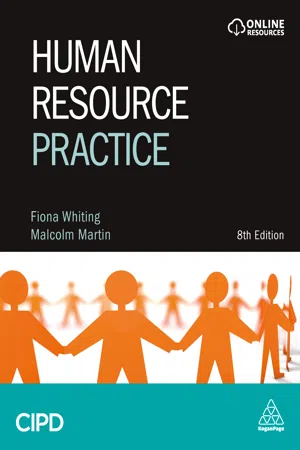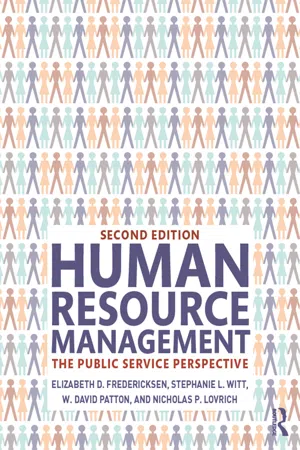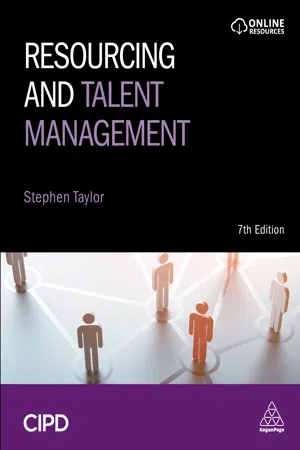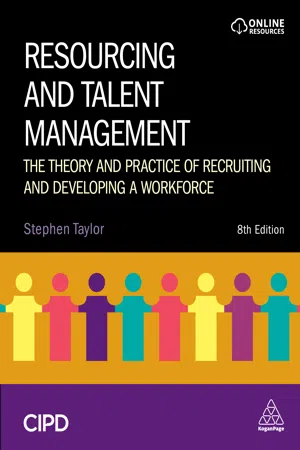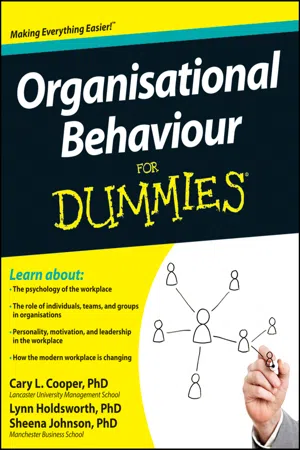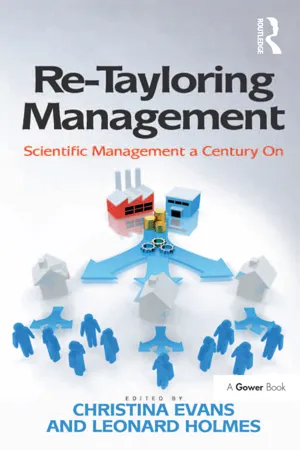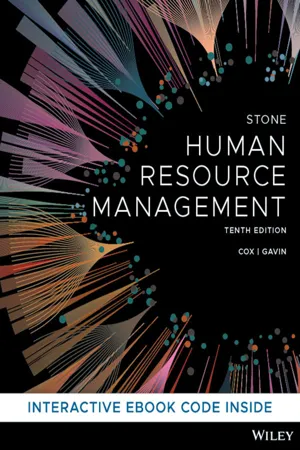Business
Job Design
Job design refers to the process of structuring and organizing tasks, responsibilities, and duties within a job. It involves determining the content, methods, and relationships of jobs to satisfy technological and organizational requirements as well as the personal needs of jobholders. Effective job design aims to enhance productivity, job satisfaction, and employee well-being.
Written by Perlego with AI-assistance
Related key terms
10 Key excerpts on "Job Design"
- Carla Jackie Sampson, Bruce J. Fried(Authors)
- 2023(Publication Date)
- Gateway to Healthcare Management(Publisher)
Rapid change in healthcare makes accurate job analysis more important now and in the future. Historically, job analysis was conducted and then set aside for a time before an employer acted on its findings. Today, job requirements are in such a constant state of flux that job descriptions and specifications must be constantly reviewed to keep them relevant. Organizations that do not revise or review job descriptions and specifications may recruit new employees who do not possess the needed skills or may not provide necessary training to update employee skills.JOB DESIGNJob Design is an outgrowth of job analysis and is the process of structuring jobs by determining the specific tasks to be performed, the methods used in performing those tasks, and how the job relates to other jobs. The goal is to maximize or enhance organizational efficiency and employee job satisfaction. The process involves changing, eliminating, modifying, and enriching duties and tasks to capture the talents of employees so that they can contribute to the organization as much as possible, develop professionally, and enhance organizational performance. Job Design should simultaneously help achieve organizational objectives and recognize the capabilities and needs of those who perform the job.Job Design encompasses how a given job is defined and how it will be conducted, which involve such decisions as whether the job will be handled by an individual or by a team of employees and such determinations as how the job fits into the overall organization. Organizing tasks, duties, and responsibilities into a unit of work to achieve an objective requires conscious effort. Each Job Design process must acknowledge employees’ unique skills and must incorporate appropriate professional guidelines or task limitations.A recent survey of 218 professionals and managers by SHRM and Harvard Business Review- eBook - ePub
- Fiona Whiting, Malcolm Martin(Authors)
- 2020(Publication Date)
- CIPD - Kogan Page(Publisher)
(For more on motivation and employee engagement see Chapters 6 and 8.) There are a number of elements to consider when designing jobs (adapted from the CIPD Factsheet on Job Design, 2019): The nature and content of each job – to ensure it is as meaningful as possible and does not involve work overload or underload. How the job characteristics (see above) can be incorporated. Working patterns and flexible working. Ergonomics – taking physical aspects of a role into account, such as any repetitive movement required or extended periods of sitting/standing. Workflow – how the tasks in one job relate to another, or to other business processes, and how these can be sequenced to be most effective. Health and safety matters to ensure employee wellbeing is taken into account. The labour market and the skills and capabilities available. Future-proofing and sustainability so that jobs can be flexible enough to respond to changing context and circumstances and to offer opportunities for growth and development to the job-holder. At this point it is worth making a note about organisation design : this is a much broader, more holistic activity and specialism, but one that informs the Job Design process. Organisation design is about delivering the overall business purpose and strategy by organising the work in a way that delivers both for customers and in terms of the experience and satisfaction of employees. Organising the work encompasses matters as diverse as considering what business processes are appropriate (for instance will lean processes deliver efficiency), what structures will best support delivery of the strategy, how jobs should be designed, what resources and capabilities are needed, what should be done in-house and what should be outsourced, and so on - eBook - ePub
Human Resource Management
The Public Service Perspective
- Elizabeth D. Fredericksen, Stephanie L. Witt, W. David Patton, Nicholas P. Lovrich(Authors)
- 2015(Publication Date)
- Routledge(Publisher)
In a different vein, Cox and Finley (1995) examined the role that organizational level and work specialization had on attitudes toward work and other indicators of workplace adaptation. They anticipated that work specialization and organizational level shaped the experiences that employees had and shaped the perceptions that employees held about their own work and their own role in the organization. The latter dimension is particularly of interest for employees who are ‘minorities’ within their organization—that is, either in less-common occupations (e.g., a community relations outreach specialist in a civil engineering unit) or in demographic groups that are less well represented. They found that, although gender, race, and age tend to matter in terms of job performance, compensation satisfaction, and allegiance with organizational identity (1995, p. 83), these findings were compounded by degree of work specialization and level of hierarchy. “Different specializations or levels may represent different work cultures … differences in rates of promotion and in job performance ratings may be attributable to different opportunity structures and different performance expectations across groups” (Cox and Finley 1995, p. 83).Hierarchy and job classification can serve to alienate groups of workers from one another in a way similar to gender and race (Erez 2010). Consequently, one important task for HRM is the promotion of activities such as strategic planning to reinforce the realization that organizations reflect collective efforts to accomplish shared goals, and those goals are most effectively approached by organizations wherein inclusiveness, trust, and mutual support are broadly practiced norms of conduct.Job DesignJob Design reflects a slightly different focus in perspective than ‘classic’ analysis, description, and evaluation. Recall our earlier discussion about organization theory and the structuring of the organization or the position to achieve efficiencies or a certain level of performance. By contrast, Job Design is a bit more organic, meaning adaptive and flexible in nature. Jobs are designed in consideration of the organization’s goals and resources as well as the individual’s goals and resources. The resulting job would be some composite, reflecting the best fit for both the organization and the individual.As organizational structure becomes flatter, and work groups evolve and become increasingly project-driven, jobs have changed in accord. In the area of Job Design, the analysis begins with what needs to be done (hence, the close connection between strategic planning and job analysis). After determining who will do the work (recruitment and selection), the designer would determine the processes and the locations where work should be accomplished. Job Design entails framing work and tasks in the context of overall organizational goals and in concert with stakeholder interests in the organizational environment. The design of some aspects of the job may even be further adapted to mesh with the characteristics or needs of the employees performing the work (for example, providing accommodations for employees with disabilities). As we noted in Chapter 1 - eBook - ePub
- Stephen Taylor(Author)
- 2018(Publication Date)
- CIPD - Kogan Page(Publisher)
Central to their argument is the view that, unless individual workers feel ‘psychologically empowered’, job satisfaction, and hence performance levels, cannot be maximised. They also go on to point to recent developments in work and argue that the Hackman and Oldham framework needs to be extended in order to take account of the rise of ‘emotional labour’, IT systems which monitor work, technologies that blur the boundaries between home and work, and increased uncertainty about the future development of jobs and organisations. These, along with other developments, raise the likelihood that employees will suffer stress, burnout and depression. As a result, when designing jobs, organisations need to do more than look at the tasks the job holder performs; they need to look also at the environment in which they are performed.More recently, Greg Oldham (2012) has revisited the original job characteristics model in the light of the considerable body of research that has been carried out developing it over the past 35 years. He concludes not only that its principal findings remain entirely valid for jobs in the contemporary workplace, but that further advantages can now be identified which follow from thoughtful and effective Job Design in addition to job satisfaction, motivation and work effectiveness. First, he presents evidence that employees are more likely to develop and display creativity when their jobs are well-designed, autonomy being especially important here. Second, he shows that altruism (ie a lack of selfishness in dealing with fellow employees) is a further likely outcome. More tentatively, he goes on to suggest that there are grounds for believing that sound Job Design is also linked to a willingness on the part of employees to learn new skills and to demonstrate resilience at difficult times. More generally, he argues that people who are fortunate to have well-designed jobs are more likely than most to develop self-belief and to enjoy a higher quality of family life. These are big claims to make, and further research is needed in all areas to demonstrate that this range of positive outcomes is definitely associated with Job Design, but the case that Oldham makes is both credible and appealing. Oldham (2012: 657–8) also suggests, if rather cautiously, that a sixth ‘job characteristic’ might usefully be added to the original five as a result of more recent research in contemporary workplaces. The suggestion here is that jobs that incorporate social interaction with other people are more satisfying and likely to lead to high levels of performance on the part of job holders than those that are more isolated in nature. The effect occurs, not least, because having a social job provides much more opportunity for others to give you positive feedback on your performance, which we know is a highly effective motivating factor. - eBook - ePub
Resourcing and Talent Management
The Theory and Practice of Recruiting and Developing a Workforce
- Stephen Taylor(Author)
- 2021(Publication Date)
- CIPD - Kogan Page(Publisher)
Central to their argument is the view that, unless individual workers feel ‘psychologically empowered’, job satisfaction, and hence performance levels, cannot be maximised. They also go on to point to recent developments in work and argue that the Hackman and Oldham framework needs to be extended in order to take account of the rise of ‘emotional labour’, IT systems which monitor work, technologies which blur the boundaries between home and work, and increased uncertainty about the future development of jobs and organisations. These along with other developments raise the likelihood that employees will suffer stress, burnout and depression. As a result, when designing jobs, organisations need to do more than look at the tasks the job holder performs; they need to look also at the environment in which they are performed.More recently Greg Oldham (2012) revisited the original job characteristics model in the light of the considerable body of research that has been carried out developing it over the past 35 years. He concludes not only that its principal findings remain entirely valid for jobs in the contemporary workplace, but that further advantages can now be identified which follow from thoughtful and effective Job Design in addition to job satisfaction, motivation and work effectiveness. First, he presents evidence that employees are more likely to develop and display creativity when their jobs are well designed, autonomy being especially important here. Second, he shows that altruism (ie a lack of selfishness in dealing with fellow employees) is a further likely outcome. More tentatively, he goes on to suggest that there are grounds for believing that sound Job Design is also linked to a willingness on the part of employees to learn new skills and to demonstrate resilience at difficult times. More generally, he argues that people who are fortunate to have well-designed jobs are more likely than most to develop self-belief and to enjoy a higher quality of family life. These are big claims to make, and further research is needed in all areas to demonstrate that this range of positive outcomes is definitely associated with Job Design, but the case that Oldham makes is both credible and appealing. Oldham (2012: 657–8) also suggests, if rather cautiously, that a sixth ‘job characteristic’ might usefully be added to the original five as a result of more recent research in contemporary workplaces. The suggestion here is that jobs which incorporate social interaction with other people are more satisfying and likely to lead to high levels of performance on the part of job holders than those which are more isolated in nature. The effect occurs, not least, because having a social job provides much more opportunity for others to give you positive feedback on your performance, which we know is a highly effective motivating factor. - eBook - ePub
Managing Research, Development and Innovation
Managing the Unmanageable
- Ravi Jain, Harry C. Triandis, Cynthia W. Weick(Authors)
- 2010(Publication Date)
- Wiley(Publisher)
4Job Design AND ORGANIZATIONAL EFFECTIVENESSA major consideration in designing jobs is the match between the requirements of the organization and the requirements of individuals. To design a job optimally, one needs to consider the abilities, interests, and personality of the individuals as well as the needs of the organization. For example, the organization may find it best to have people follow precisely the rules and regulations that the organization develops, but individuals often find it much more satisfying if they have considerable freedom in deciding how to behave within the organization. The individual’s freedom, on the other hand, cannot be unlimited, so jobs have to be designed in such a way that a balance is achieved between the needs of the organization and the needs of the individuals. Some individuals, because of their personality, have an especially strong need for autonomy and will require a job that is designed with far more freedom than is necessary for the majority of individuals.The organization must be concerned with the compatibility of individual goals with those of the organization in order to maximize the motivation of individuals and to minimize friction among them. However, individual needs can be satisfied in a number of ways, and they tend to change with experience, maturity, and the individual’s stage in life. For example, security may be less important to an unmarried 20-year-old than to a married 45-year-old. Security can also be satisfied in different ways (e.g., a social security system that operates over a long period or a high salary for a short period of time). In matching individual and organizational goals there is necessarily some give-and-take in both directions, probably with the individual giving more than the organization, simply because the organization cannot bend as easily as can an individual. - eBook - ePub
- Cary Cooper, Sheena Johnson, Lynn Holdsworth(Authors)
- 2012(Publication Date)
- For Dummies(Publisher)
An employer may presume that an employee is motivated only by pay, and how they do their job doesn’t matter (within reason!). But for many employees, the design of their job matters as much as getting paid. If you think about a job on the conveyer belt of the meat-processing factory (see the previous section), these types of jobs are boring and repetitive and can make you feel dissatisfied and demotivated. As a consequence, the job can have a negative effect on your physical and psychological health and lead to absenteeism or even employee turnover.See Chapter 9 and Herzberg’s two-factor theory of hygiene factors and motivators to appreciate what can lead to satisfaction and dissatisfaction at work.Although you can become skilled and capable of doing a repetitive job, the lack of variety can also drive you up the wall. You feel bored and totally removed from the overall goals of the business. You’re not really bothered about how your job contributes to any organisational success. As long as you do your job passably, nothing else about the business matters to you.A potential solution to this problem is to provide employees with more variety in their work, and we look at ways to do provide this variety in the next section.Successful Job Design is about creating jobs that are more intrinsically satisfying and motivating.Looking at Different Types of Job Design To design jobs well, you need to consider the following:What does the employee actually do?How long does the employee do the job?When and where do they do the job?Job Design doesn’t have to focus on a single job; it’s mainly used on groups of jobs. When we go into organisations, we often use employee attitude surveys (see Chapter 4) to assess job satisfaction among groups of employees and use these findings to inform Job Design ideas.Job Design can take a variety of forms:Rotation: Varying the tasksEnlargement: Providing more and varied tasksEnrichment: Giving some responsibilityCreating variety Job rotation - eBook - ePub
- Maria C.W. Peeters, Jan de Jonge, Toon Taris(Authors)
- 2023(Publication Date)
- Wiley-Blackwell(Publisher)
This will explain why in recent times it is still playing a crucial role. Job Design is concerned with the activities of workers, and relates to the duties and tasks required to perform their work, and how those tasks and duties are structured and scheduled (Morgeson & Humphrey, 2008 ; Parker & Ohly, 2008). Job Design has a long history of political and societal regulations, for example, medieval Europe had a six-day working week, with a day of rest afterward enforced by the Christian Church. The publication of Adam Smith’s Wealth of Nations (1776/1904) marked a significant shift in how Job Design was construed (Leahey, 1987). Smith was particularly concerned with efficient production. He argued that tasks should be divided into their smallest possible components and that workers should perform one task only. This division of labor exerted huge influence on the Industrial Revolution, which started in England in the eighteenth century and spread throughout the Western world in the nineteenth century. The division of labor became the basis of Scientific Management, introduced by the American engineer and management thinker Frederick Taylor (1911) in the early twentieth century (see also Chapter 1). Scientific management was based on a simple—and potentially flawed—view of human motivation: workers were rewarded financially on the basis of how many times they completed simplified tasks. One of the best-known critics of the division of labor is Karl Marx (1971a, 1971b). Marx argued that the division of labor was a process through which employers and managers could extract the maximum amount of “surplus value” from workers. In order to make a profit, they require industrial processes that produce goods cheaper than their price, which, Marx argued, entails paying workers less for their labor than the actual value of their labor in the production process - eBook - ePub
Re-Tayloring Management
Scientific Management a Century On
- Leonard Holmes, Christina Evans(Authors)
- 2016(Publication Date)
- Routledge(Publisher)
CIPD 2006a : 4).This next section discusses a more contemporary view of Job Design – the concept of 'job crafting' – where individuals appear more in control of shaping their job role on a day-to-day basis in order to meet their affective needs; for example, a desire for work to be more interesting, or meaningful (Shuck and Wollard 2010 ).Contemporary Perspective on Job Design – ‘Job Crafting'
More recently, certainly amongst the academic community, there has been a growing interest in the concept of 'job crafting' (Wrzesniewski and Dutton 2001 , Arnold 2011 ), which Wrzesniewski and Dutton (2001 : 179) define as 'the physical and cognitive changes individuals make in the task, or relational boundaries of their work'. Whereas job enlargement/enrichment is a top-down managerialist approach to Job Design (group-based), job crafting is perceived as a proactive, improvised, dynamic and bottom-up form of Job Design, initiated by individuals. Job crafting is not a formalized management process, but an individualized situated activity; situated in the sense that it is the individual who initiates changes, on a day-to-day basis, about how to carry out different aspects of their work in order to derive more meaning from the work that they do. Crafting then can take many forms: taking on additional tasks; changing the nature and, or scope, of day-to-day relationships with others, as well as creating new relationships, or refraining one's own perception of how meaningful/impactful a specific job role is (Wrzesniewski and Dutton 2001 , Berg et al. 2010 ). Thus in contrast to traditional Job Design approaches, such as Hackman and Oldham's (1980), where managers try to elicit the meaning that employees derive from pre-defined tasks, job crafting is assumed to work on reverse causality; that is, 'the opportunity and motivation to craft elicit job crafting', even in jobs that might be low in autonomy (Wrzesniewski and Dutton 2001 - eBook - ePub
- Raymond J. Stone, Anne Cox, Mihajla Gavin(Authors)
- 2020(Publication Date)
- Wiley(Publisher)
11Ajob descriptiondefines what a job is by identifying its content, requirements and context. Providing a written summary of the duties and responsibilities of the job, job descriptions help managers and current and prospective employees to understand what the job is and how it is to be performed.- • Job specifications focus on the knowledge, skills, abilities, personal characteristics and formal qualifications that an employee must possess to perform the job successfully.
- • Job Design identifies what work must be performed, how it will be performed, where it is to be performed and who will perform it. Job analysis information is invaluable in determining which tasks should be grouped together to form a job, and for structuring jobs so that employee satisfaction and performance can be enhanced.
Job analysis information can help identify and clarify the organisational structure and design. Clarifying job requirements and the interrelationships among jobs means that job content, tasks, duties and responsibilities can be specified at all levels, thus promoting efficiency by minimising overlap or duplication.12HR planning involves having the right number of qualified people in the right jobs at the right time. Job analysis information is essential for HR planning because it helps to accurately determine the number and types of employees to be recruited or exited from the organisation.Job analysis information aids the recruitment process by identifying the job requirements and enabling HR managers to target their recruiting efforts and attract superior candidates. In addition, job analysis identifies irrelevant and/or inaccurate job information, thus facilitating more realistic job previews (ensuring that job applicants receive pertinent positive and negative information about the job, resulting in better matching of people and jobs).
Index pages curate the most relevant extracts from our library of academic textbooks. They’ve been created using an in-house natural language model (NLM), each adding context and meaning to key research topics.

